|
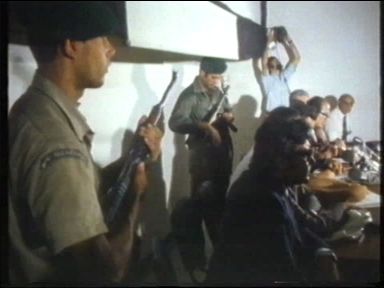 On 15 July 1974 extreme
elements nationalist of the National Guard led by its Greek officers
launched a military coup with the objective of overthrowing the Government.
The Presidential Palace was bombed but, for the third time Makarios escaped
and was flown out of Cyprus by British forces. Nicos Sampson was installed
as President. Sampson was well known for his paramilitary involvement, and
as the owner of a news paper, with fanatical pro-Greek nationalistic
leanings. The coup was, in essence, a short term civil war between Greek
factions and was completely unrelated to the inter-communal issue which had
been dormant for seven years. Indeed, the perpetrators of the coup went out
of their way to tell the world that this was an internal Greek matter. The
situation was now quite different to that of 1963/64. The coup involved
only the Greek Cypriots and, as Denktash had acknowledged, the Turkish
Cypriots were mere spectators. On 15 July 1974 extreme
elements nationalist of the National Guard led by its Greek officers
launched a military coup with the objective of overthrowing the Government.
The Presidential Palace was bombed but, for the third time Makarios escaped
and was flown out of Cyprus by British forces. Nicos Sampson was installed
as President. Sampson was well known for his paramilitary involvement, and
as the owner of a news paper, with fanatical pro-Greek nationalistic
leanings. The coup was, in essence, a short term civil war between Greek
factions and was completely unrelated to the inter-communal issue which had
been dormant for seven years. Indeed, the perpetrators of the coup went out
of their way to tell the world that this was an internal Greek matter. The
situation was now quite different to that of 1963/64. The coup involved
only the Greek Cypriots and, as Denktash had acknowledged, the Turkish
Cypriots were mere spectators.
Between 1967 and 1974
relations between Greek and Turkish Cypriots had much improved, with no
further incidents of violence by either government or paramilitary groups.
The Turks moved freely around the island. The enclaves existed only to
sustain the argument for separation, although about 6,000 Turkish Cypriots
had drifted back to their homes outside of the enclaves by the early 1970s.
Only four months before the coup, Denktash was invited to speak at a Greek
Cypriot gathering of businessmen and professionals. There was a readiness
on the part of various groups of both communities to take part in seminars
organised to promote inter-ethnic understanding. The improvement in
relations between Greek and Turkish Cypriots is acknowledged, even by the
most partisan of Turcophile commentators. It is therefore extremely
difficult to identify a legitimate fear on the part of the Turkish Cypriot
as a result of the coup. The only human victims of the coup were the Greek
Cypriots.
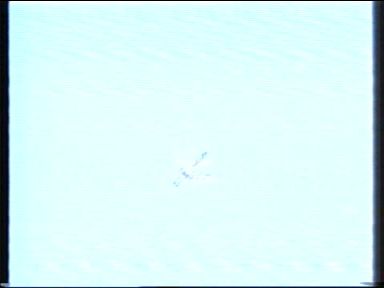 Having received reports
of an impending coup, the US State Department and Kissinger in particular
chose not to prevent it, fuelling the allegations that it had tacitly
supported it. Thomas Boyatt, the Cyprus Desk officer in the State
Department warned consistently of a coup and the inevitable Turkish
response. Boyatt had served as a diplomat on the island. He confirmed that
the Junta was planning an attack on Cyprus. His pre-coup memoranda were
classified as secret and have never been released. Indeed, after the
invasion Boyatt was forbidden by Kissinger to testify before Congress, and
finally did so only in order to avoid being cited for contempt. Evidence
was only taken in executive session of Congress, so sensitive was it
considered to be. In July 1974, even the Greek Cypriot daily Apogevmatini
described in its editorial the impending coup to be carried out by EOKA-B.
The US responded with a wait and see policy. After all, the outcome could
well suit them, and it did. Five days after the coup Turkey invaded, and
unlike 1964, there was no urging of restraint by the US State Department.
There was now no need because the US-backed Junta would not go to war
against Turkey without American consent. Turkish troops landed in Kyrenia
in the early hours of 20 July 1974. Having received reports
of an impending coup, the US State Department and Kissinger in particular
chose not to prevent it, fuelling the allegations that it had tacitly
supported it. Thomas Boyatt, the Cyprus Desk officer in the State
Department warned consistently of a coup and the inevitable Turkish
response. Boyatt had served as a diplomat on the island. He confirmed that
the Junta was planning an attack on Cyprus. His pre-coup memoranda were
classified as secret and have never been released. Indeed, after the
invasion Boyatt was forbidden by Kissinger to testify before Congress, and
finally did so only in order to avoid being cited for contempt. Evidence
was only taken in executive session of Congress, so sensitive was it
considered to be. In July 1974, even the Greek Cypriot daily Apogevmatini
described in its editorial the impending coup to be carried out by EOKA-B.
The US responded with a wait and see policy. After all, the outcome could
well suit them, and it did. Five days after the coup Turkey invaded, and
unlike 1964, there was no urging of restraint by the US State Department.
There was now no need because the US-backed Junta would not go to war
against Turkey without American consent. Turkish troops landed in Kyrenia
in the early hours of 20 July 1974.
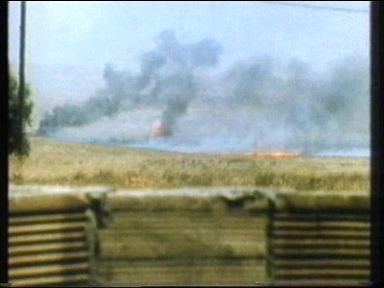 From 1967 until the
time of the coup in 1974, there had been no further recorded incidents of
inter-communal violence in Cyprus. Turkey’s alleged legal justification for
her invasion in 1974 was founded under article (iv) of the Treaty of
Guarantee which permits intervention, but for the sole purpose of restoring
the constitutional arrangements as laid down in the London-Zurich
agreements of 1959, not for the purpose of over-throwing them altogether.
The article is also silent about the use of armed force in this restoration
as a result of unilateral intervention. The British, who had imposed
themselves as one of the three guarantor powers, and in the defence of many
having caused an inter-communal problem where one had existed by abusing
the status of the Turkish-Cypriot minority, now decided to avoid their
obligations under the 1960 Treaty of Guarantee. Having insisted on the
treaty in 1960, Britain’s Foreign Secretary in 1974, James Callaghan,
although greatly dissapointed by Kissinger’s attitude, abdicated all
responsibility to US Secretary of State. From 1967 until the
time of the coup in 1974, there had been no further recorded incidents of
inter-communal violence in Cyprus. Turkey’s alleged legal justification for
her invasion in 1974 was founded under article (iv) of the Treaty of
Guarantee which permits intervention, but for the sole purpose of restoring
the constitutional arrangements as laid down in the London-Zurich
agreements of 1959, not for the purpose of over-throwing them altogether.
The article is also silent about the use of armed force in this restoration
as a result of unilateral intervention. The British, who had imposed
themselves as one of the three guarantor powers, and in the defence of many
having caused an inter-communal problem where one had existed by abusing
the status of the Turkish-Cypriot minority, now decided to avoid their
obligations under the 1960 Treaty of Guarantee. Having insisted on the
treaty in 1960, Britain’s Foreign Secretary in 1974, James Callaghan,
although greatly dissapointed by Kissinger’s attitude, abdicated all
responsibility to US Secretary of State.
In response to the
Turkish invasion, the Greek army attempted to mobilise, but the
mobilisation never really got off the ground. In addition, in Cyprus Greek
troops were repeatedly withdrawn by the officers from the front-line
offering an unfettered line of advance to the Turks. It was almost as if
the partition of the island was pre-arranged. The corruption and
incompetence of the junta over the previous six years had taken its toll.
Within a few days of the invasion, the junta in Athens collapsed, followed
by its puppet regime in Nicosia. Power returned to civilians under
Constantine Karamalis in Greece, while the Greek Presidency went to Glafkos
Clerides, Makarios’ deputy. Constitutional order, under which Turkey
attempted to justify her invasion, was now restored. The cease-fire arranged
by the UN now simply acted as a respite to give Turkey an opportunity to
consolidate her gains and bringing in massive reinforcements to complete
her strategic contingent.
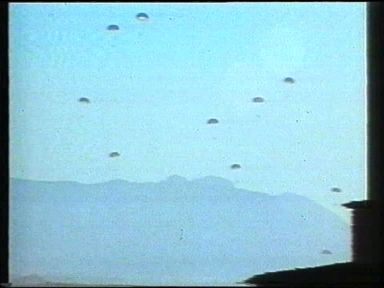 It is, however, very
hard to find any legal justification for Turkey’s appalling violations of
human rights in Cyprus as witnessed by the findings of the Council of
Europe. We know today that thousands of Cypriot civilians were murdered or
tortured. Many women and children still remain missing. Over 1,000 women
were raped. How can this appalling brutality be justified by an attempt to
restore a constitution? It is, however, very
hard to find any legal justification for Turkey’s appalling violations of
human rights in Cyprus as witnessed by the findings of the Council of
Europe. We know today that thousands of Cypriot civilians were murdered or
tortured. Many women and children still remain missing. Over 1,000 women
were raped. How can this appalling brutality be justified by an attempt to
restore a constitution?
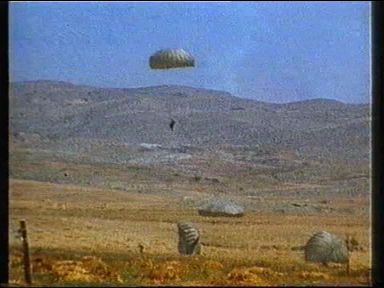 Further support for the
argument that the Turkish Government’s real goal was not the restoration of
constitutional order but sheer order, becomes apparent when looking at the Geneva
peace conference called in the wake of the original July invasion. Further support for the
argument that the Turkish Government’s real goal was not the restoration of
constitutional order but sheer order, becomes apparent when looking at the Geneva
peace conference called in the wake of the original July invasion.
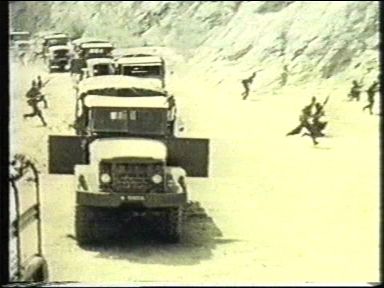 On 9 August 1974, when
Turkey held only the narrow Kyrenia-Nicosia corridor, the Turkish foreign
minister handed an ultimatum to the Greek Cypriot negotiator Glafkos
Clerides demanding the immediate cessation of 35% of Cypriot territory to
the Turkish army. When Clerides requested 36 hours to discuss it with his
Government, not a wholly unreasonably request given the circumstances, his
request was denied. On 9 August 1974, when
Turkey held only the narrow Kyrenia-Nicosia corridor, the Turkish foreign
minister handed an ultimatum to the Greek Cypriot negotiator Glafkos
Clerides demanding the immediate cessation of 35% of Cypriot territory to
the Turkish army. When Clerides requested 36 hours to discuss it with his
Government, not a wholly unreasonably request given the circumstances, his
request was denied.
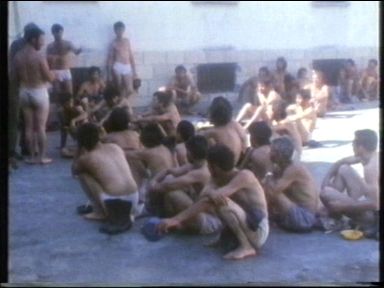 As regards Gunes,
Turkish negotiator, the demand was non-negotiable. Turkey then launched a
second invasion on 14 August 1974, this time conquering 37% of the
territory of the Republic of Cyprus. By then the Sampson regime had fallen,
as had the Greek Junta. Following this second offensive begun on 14 August,
Greek-Cypriot retaliatory action began against the Turks after the ethnic
cleansing of Greek Cypriots from their homes had occurred, and the majority
of the human rights violations were becoming known. In the village of
Tokni, 69 Turkish Cypriots were killed and later found in a mass grave. In
Aloa, 57 Turkish Cypriots were killed, while in Maratha a further 88
corpses were discovered in a mass grave. As regards Gunes,
Turkish negotiator, the demand was non-negotiable. Turkey then launched a
second invasion on 14 August 1974, this time conquering 37% of the
territory of the Republic of Cyprus. By then the Sampson regime had fallen,
as had the Greek Junta. Following this second offensive begun on 14 August,
Greek-Cypriot retaliatory action began against the Turks after the ethnic
cleansing of Greek Cypriots from their homes had occurred, and the majority
of the human rights violations were becoming known. In the village of
Tokni, 69 Turkish Cypriots were killed and later found in a mass grave. In
Aloa, 57 Turkish Cypriots were killed, while in Maratha a further 88
corpses were discovered in a mass grave.
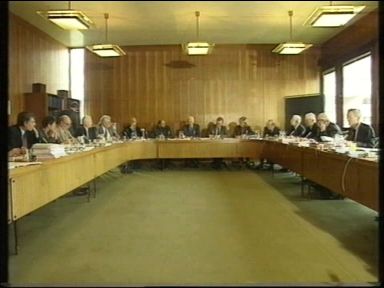 Following the invasion
a report was prepared by the Commission of the Council of Europe as a
result of a complaint by the Cyprus Government. The report examines alleged
breaches of the articles of the Convention of Human Rights of which each
member of the Council of Europe (including Turkey) is a signatory. The
following is the summary as printed by the "Sunday Times" on 23
January 1977: Following the invasion
a report was prepared by the Commission of the Council of Europe as a
result of a complaint by the Cyprus Government. The report examines alleged
breaches of the articles of the Convention of Human Rights of which each
member of the Council of Europe (including Turkey) is a signatory. The
following is the summary as printed by the "Sunday Times" on 23
January 1977:
KILLING Relevant
Article of Human Rights Convention:- Everyone’s right to life shall be
protected by law.
Charge made by Greek Cypriots: The Turkey army
embarked on a systematic course of mass killings of civilians unconnected
with any war activity.
Evidence given to the Commission: Witness Mrs K
said that on 21 July 1974, the second day of the Turkish invasion, she and
a group of villages from Elia were captured when, fleeing from bombardment,
they tried to reach a range of mountains. All 12 men arrested were
civilians. They were separated from the women and shot in front of the
women, under orders of a Turkish officer. Some of the men were holding
children, three of whom were wounded.
Written statements referred to two more group
killings: at Trimithi, eye-witnesses told of the deaths of five men (two
shepherds aged 60 and 70, two masons of 20 and 60, and a 19 year-old
plumber). At Palekythron 30 Greek Cypriot soldiers being held prisoner were
killed by their captors, according to the second statement.
Witness S gave evidence of two other mass
killings at Palekythron. In each case, between 30 and 40 soldiers who had
surrendered to the advancing Turks were shot. In the second case, the
witness said: "the soldiers were transferred to the kilns of the
village where they were shot dead and burnt in order not to leave details
of what had happened".
Seventeen members of two neighbouring families,
including 10 women and five children aged between two and nine were also
killed in cold blood at Palekythron, reported witness H, a doctor. Further
killings described in the doctor’s notes, recording evidence related to him
by patients (either eye-witnesses or victims), included;
· Execution of eight civilians
taken prisoner by Turkish soldiers in the area of Prastio, one day after
the cease-fire on 16 August 1974.
· Killing by Turkish soldiers of
five unarmed Greek Cypriot soldiers who had sought refuge in a house at
Voni.
· Shooting of four women, one of
whom survived by pretending she was dead.
Further evidence, taken in refugee camps and in
the form of written statements, described killings of civilians in homes,
streets or fields, as well as the killing of people under arrest or in
detention. Eight statements described the killing of soldiers not in
combat; five statements referred to a mass grave found in Dherynia.
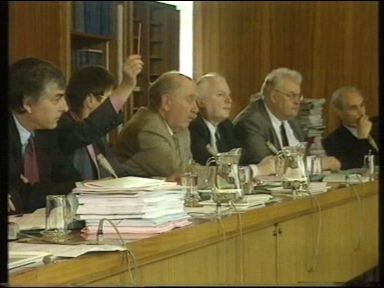 Commission’s verdict: By 14 votes to one, the
Commission considered there were "very strong indications" of
violation of Article 2 and killings "committed on a substantial
scale". Commission’s verdict: By 14 votes to one, the
Commission considered there were "very strong indications" of
violation of Article 2 and killings "committed on a substantial
scale".
RAPE Relevant
Article:- No one shall be subjected to torture or to in-human or degrading
treatment or punishment.
Charge:- Turkish troops were responsible for
wholesale and repeated rapes of women of all ages from 12 to 71. Sometimes
to such an extent that the victims suffered haemorrhages or became mental
wrecks. In some areas, enforced prostitution was practised, all women and
girls of a village being collected and put into separate rooms in empty houses
where they were raped repeatedly.
In certain cases members of the same family were
repeatedly raped, some of them in front of their own children. In other
cases women were brutally raped in public.
Rapes were on many occasions accompanied by
brutality such as violent biting of the victims, causing severe wounding,
banging their heads on the floor and wringing their throats almost to the
point of suffocation. In some cases attempts to rape were followed by the
stabbing or killing of the victims, including pregnant and
mentally-retarded women.
Evidence given to Commission:- Testimony of
doctors C and H, who examined the victims. Eye-witnesses and hearsay
witnesses also gave evidence, and the Commission had before it written
statements from 41 alleged victims.
Dr H said he had confirmed rape in 70 cases,
including:-
· A mentally-retarded girl of 24
was raped in her house by 20 soldiers. When she started screaming they
threw her from the second floor window. She fractured her spine and was
paralysed.
· One day after their arrival at
Voni, Turks took girls to a nearby house and raped them. ? One woman from
Voni was raped on three occasions by four persons each time. She became
pregnant.
· One girl, from Palekythrou, who
was held with others in a house, was taken out at gun point and raped.
· At Tanvu, Turkish soldiers tried
to rape a 17 year-old girl. She resisted and was shot dead.
· A woman from Gypsou told Dr H
that 25 girls were kept by Turks at Marathouvouno as prostitutes.
Another witness said his wife was raped in front
of their children. Witness S told of 25 girls who complained to Turkish
officers about being raped and were raped again by the officers. A man
(name withheld) reported that his wife was stabbed in the neck while
resisting rape. His grand-daughter, aged six, had been stabbed and killed
by Turkish soldiers attempting to rape her.
A Red Cross witness said that in August 1974,
while the island’s telephones were still working, the Red Cross Society
received calls from Palekythrou and Kaponti reporting rapes. The Red Cross
also took care of 38 women released from Voni and Gypsou detention camps;
all had been raped, some in front of their husbands and children. Others
had been raped repeatedly, or put in houses frequented with Turkish
soldiers.
These women were taken to Akrotiri hospital, in
the British Sovereign Base Area, where they were treated. Three were found
to be pregnant. Reference was also made to several abortions performed at
the base.
Commission’s verdict:- By 12 votes to one the
Commission found "that the incidents of rape described in the cases
referred to and regarded as established constitute "in-human treatment"
and thus violations of Article 3 for which Turkey is responsible under the
Convention."
TORTURE Relevant
article:- see above under Rape.
Charge: Hundreds of people, including children,
women and pensioners, were victims of systematic torture and savage and
humiliating treatment during their detention by the Turkish army. They were
beaten, according to the allegations, sometimes to the extent of being
incapacitated. Many were subjected to whipping, breaking of their teeth,
knocking their heads against walls, beating with electrified clubs,
stubbing of cigarettes on their skin, jumping and stepping on their chests
and hands, pouring dirty liquids on them, piercing them with bayonets, etc.
Many, it was said, were ill-treated to such an
extent that they became mental and physical wrecks. The brutalities
complained of reached their climax after the cease-fire agreements; in
fact, most of the acts described were committed at a time when Turkish
armed forces were not engaged in any war activities.
Evidence to Commission: Main witness was a school
teacher, one of 2,000 Greek Cypriot men deported to Turkey. He stated that
he and his fellow detainees were repeatedly beaten after their arrest, on
their way to Adana (in Turkey), in jail at Adana and in prison camp at Amasya.
On ship to Turkey:- "That was another moment
of terrible beating again. We were tied all the time. I lost the sense of
touch. I could not feel anything for about two or three months. Every time
we asked for water or spoke we were beaten."
Arriving at Adana:- "... then, one by one,
they led us to prisons, through a long corridor .. Going through that
corridor was another terrible experience. There were about 100 soldiers
from both sides with sticks, clubs and with their fists beating every one
of us while going to the other end of the corridor. I was beaten at least
50 times until I reached the other end.
"In Adana anyone who said he wanted to see a
doctor was beaten.
"Beating was on the agenda every day. There
were one or two very good, very nice people, but they were afraid to show
their kindness, as they told us."
Witness P spoke of:-
· A fellow prisoner who was kicked
in the mouth. He lost several teeth "and his lower jaw came off in
pieces".
· A Turkish officer, a karate
student, who exercised every day by hitting prisoners.
· Fellow prisoners who were hung
by the feet over the hole of a lavatory for hours.
· A Turkish second lieutenant who
used to prick all prisoners with a pin when they were taken into a yard.
Evidence from Dr H said that prisoners were in an
emaciated condition on their return to Cyprus. On nine occasions he had
found signs of wounds.
The doctor gave a general description of
conditions in Adana and in detention camps in Cyprus (at Pavlides Garage
and the Saray Prison in the Turkish quarter of Nicosia) as reported to him
by former detainees. Food, he said, consisted of one-eight of a loaf of
bread a day, with occasional olives; there were about two buckets of water
and two mugs which were never cleaned, from which about 1,000 people had to
drink; toilets were filthy, with faeces rising over the basins; floors were
covered with faeces and urine; in jail in Adana prisoners were kept 76 to a
cell with three towels between them and one block of soap per eight persons
per month to wash themselves and their clothes.
One man, it was alleged, had to amputate his own
toes with a razor blade as a consequence of ill-treatment. Caught in Achna
with another man, they had been beaten up with hard objects. When he asked
for a glass of water he was given a glass full of urine. His toes were then
stepped on until they became blue, swollen and eventually gangrenous (the
other man was said to have been taken to hospital in Nicosia, where he
agreed to have his legs amputated. He did not survive the operation).
According to witness S:- "hundreds of Greek
Cypriots were beaten and dozens were executed. They have cut off their ears
in some cases, like the case of Palekythron and Trahoni ..." (verbatim
record).
Verdict by Commission: By 12 votes to one, the
Commission concluded that prisoners were in a number of cases physically
ill-treated by Turkish soldiers.
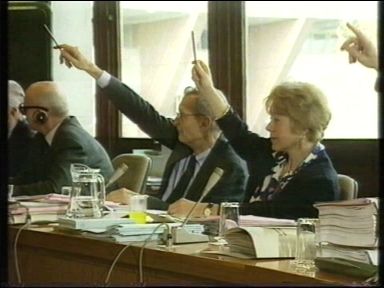 "These acts of ill-treatment caused
considerable injuries and in at least one case, death of a victim. By their
severity they constitute "in-human treatment" in the sense of
Article 3, for which Turkey is responsible under the Convention." "These acts of ill-treatment caused
considerable injuries and in at least one case, death of a victim. By their
severity they constitute "in-human treatment" in the sense of
Article 3, for which Turkey is responsible under the Convention."
LOOTING Relevant
article:- Every natural or legal person is entitled to the peaceful
enjoyment of his possessions.
Charge: In all Turkish-occupied areas the Turkish
army systematically looted houses and businesses of Greek Cypriots.
Evidence to Commission: Looting in Kyrenia was
described by witness C:- "... The first days of looting of the shops
was done by the army of heavy things like refrigerators, laundry machines,
television sets" (verbatim record).
For weeks after the invasion, he said, he had
watched Turkish naval ships taking on board the looted goods.
Witness K, a barrister, described the pillage of
Famagusta:- "At two o’clock an organised, systematic, terrifying,
shocking, unbelievable looting started ... We heard the breaking of doors,
some of them iron doors, smashing of glass, and we were waiting for them
any minute to enter the house. This lasted for about four hours."
Written statements by eye-witnesses of looting
were corroborated by several reports by the Secretary-General of the United
Nations.
Verdict of Commission: The Commission accepted
that looting and robbery on an extensive scale, by Turkish troops and
Turkish Cypriots, had taken place. By 12 votes to one, it established that
there had been deprivation of possessions of Greek Cypriots on a large
scale.
OTHER CHARGES
On four counts:- the Commission concluded that
Turkey had also violated an Article of the Convention asserting the right
to respect for private and family life, home and correspondence. The
Commission also decided that Turkey was continuing to violate the Article
by refusing to allow the return of more than 170,000 Greek Cypriot refugees
to their homes in the north.
On three counts:- the Commission said Turkey had
breached an Article laying down the right to liberty and security of
persons by confining more than 2,000 Greek Cypriots in schools and
churches.
Finally, the Commission said Turkey had violated
two more articles that specify that the rights and freedoms in the
Convention shall be secured without discrimination on any grounds, and that
anyone whose rights are violated "shall have an effective remedy
before a national authority."
The European Commission
on Human Rights has outlined in great detail the actions of the Turkish
armed forces and the treatment that it handed out to those Greek Cypriot
civilians with whom it came into contact. 5,000 Greek Cypriot civilians
were murdered, over 1,000 women were raped. Over 1,619 Greek Cypriots were
abducted and remain missing, their whereabouts never disclosed by the
Turkish authorities. The brutality the Turkish army brought with it was
specifically designed to terrify the local Greek Cypriot creating 200,000
refugees.
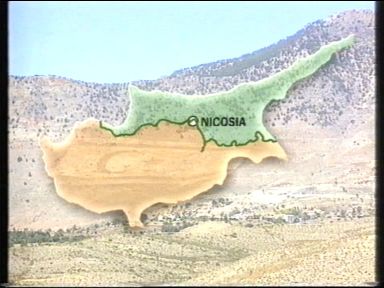 By 18 August the
Turkish army had drawn a line (aptly called the Attila line) across the
island, which remains to this day and follows the proposed line suggested in
1957 very closely. The long cherished aims of Kibris Turktur were partly
fulfilled and there have been numerous calls since 1974 from Turkish
nationalist groups to go on and "finish the job". By 18 August the
Turkish army had drawn a line (aptly called the Attila line) across the
island, which remains to this day and follows the proposed line suggested in
1957 very closely. The long cherished aims of Kibris Turktur were partly
fulfilled and there have been numerous calls since 1974 from Turkish
nationalist groups to go on and "finish the job".
An ethnic group, which
in 1964 owned about 12% of the land of Cyprus, had managed, by means of
violence and manipulation, in gaining control of over 37%.
|